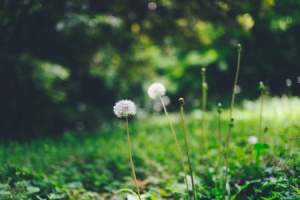Garden Weeds
The Good, the Bad, and the Ugly
Author: Robin Horton
Like the uninvited house guest that never leaves, weeds can stretch the limits of your patience and have you dreaming up creative strategies for getting rid of them. The common conception is that they are all bad and unwelcome, but do they have any redeeming qualities?

"Both humans and nature are involved in plant breeding programs. The main difference between the two programs is that man breeds plants for yield, while nature breeds plants for survival."
So how might we describe the unwelcome weed?

Weeds may be native or non-native, invasive and/or noxious, annual, biennial or perennial. Understanding the differences in their specific characteristics and growing seasons is essential for their management.
Annual, Biennial and Perennial Weeds
Annual Weeds / Summer and Winter
Annual weeds germinate, flower, and spread only by seed, generally dying within a one year.
Summer Annuals
These are often very difficult to manage. Summer annual weeds such as crabgrass, knotweed, and prostrate spurge often sprout as soil temperatures warm in spring or early summer, then grow and produce seed until the first fall frost.
Winter Annuals
Winter annuals such as shepherd's purse, common chickweed, yellow rocket and annual bluegrass germinate from seed in the late summer or early fall, propagate in spring, then die out in summer as they don’t thrive in hot temperatures.
Biennial Weeds
Many common weeds and wildflowers are biennials. These weeds have a two-year life cycle. They germinate and form a rosette (a plant form with no central stalk), then a thistle. Then they flower and produce seeds in their second year, after which they die.
Perennial Weeds / Simple and Spreading
Perennial weeds, consisting of simple and spreading varieties, do not die out after flowering and return every year.
Simple Perennials
The simple perennial weeds are also called solitary perennials because they grow individually. Simple perennials, such as dandelions, curly dock, and plantains, spread only by seed.
Spreading Perennials
Spreading perennials also emerge from seed but spread by sending out rhizomes (which grow underground) or stolons (which grow above the soil). These spreading perennials, like bermuda grass, bindweed, and ivy are the most difficult to control.
Invasive and Noxious Weeds

Invasive Weeds
An invasive plant, according to the USDA, is one that is both non-native and able to establish itself on many sites, grow quickly, and spread to the point of disrupting plant communities or ecosystems. When populating a non-native environment, these weeds often lack the natural enemies to curtail their growth, enabling them to dominate native plants and disrupt ecosystems.
Noxious Weeds
By legal definition (Federal Plant Protection Act), a noxious plant is one designated by federal, state or local government officials as injurious to public health, agriculture, recreation, wildlife or property. Once a weed is classified as noxious, authorities can implement quarantines and take actions to contain or destroy the weed in order to limit its spread.
The USDA maintains a list of federally-recognized noxious weeds and it is illegal to import listed noxious plants of any kind or transport them across state lines. You can view a list of noxious weeds by state here
Native or Non-native Weeds
According to the USDA, a native plant (or weed) is one "that is a part of the balance of nature that has developed over hundreds or thousands of years in a particular region or ecosystem." A plant is only native to a particular geographical area, so it's important to include that qualifier when referring to a plant as native (i.e., native to New England). Only those plants found in the United States before European settlement are considered to be native in this country.
How to put weeds to work

They may help retain water to increase moisture and nutrients, functioning as a type of living mulch to maintain top soil. Some weeds can help work the soil. Dandelions and radishes, for example, can have 18-inch-deep roots that act as "bio-drills" to loosen shallow layers of compacted soil.
With each vegetable garden harvest the soil loses some nutrients. From the subsoil, weeds accumulate vital nutrients that then get absorbed into their leaves. Their decaying taproots produce organic matter and entryways for worms and beneficial soil microbes that can fertilize the soil. Weeds also serve as conduits for rain and air to penetrate the soil.
Some weeds can repel other pests. Although they may seem like pests themselves, some weeds like neem can actually help control undesirable bugs while attracting beneficial insects to help maintain biodiversity in the garden.
What weeds can teach us about the soil
While weeds can be invasive and noxious, they may at times also be useful. The sprouting of weeds can reveal a lot about the soil's health, possibly signaling the need for amendments, worm castings or compost. As most weeds favor specific soil types, identifying the weed variety will offer important insight about the particular soil condition and can aid in managing the their growth.
Some weeds thrive best in moist and wet soils, while others do best in dry and sandy soils. While some prefer acidic or alkaline, hard compacted or heavy clay soils, other weeds favor well drained humus soils or low fertility soils. A little research to identify your garden's weeds will reveal a lot about your soil conditions and serve as a useful tool for improving and maintaining the garden.
Weeds so lovely you could just eat them up

On the aesthetic front, some weeds are lovely to look at. Some are wild relatives of their cultivated cousins. And there are even edible varieties packed with flavor and abundant nutrients. Dandelions, for example, are thought of as weeds, yet during their peak early spring flowering period, they will attract bees and other pollinators. Dandelion leaves can also become a tasty compliment to one's garden-to-table meal.
So as far as bad versus good, it’s all pretty much how you look at it. Check out our follow-up article: How to Naturally Control Weeds, and stay tuned for more in our new series about weeds.
MORE GARDENING ARTICLES
- Succesfully plant bare-root apple trees
- Make fruit juice without a squeezing press
- Machine picks up fallen apples for cider
- Hand-cranked Apple Peelers
- Cool Nutcrackers for Processing Nuts
- Compost Tractor: Old Piles to New Beds
- Pollinating and Fertilizing Sweet Corn
- Seed-to-Soil Contact for Best Results
- Using a Jab Planter on a Small Farm
- How To Improve Clay Garden Soil
- Weed Control: False Seed Bed Method
- Make this Loud Deer Alarm to scare them away
- Beneficial and Harmful Garden Weeds
- Natural Weed Control Techniques
- DIY Test for Herbicide in your Compost
- Antique Tractors for Weeding Vegetables
- Broadfork Handles: Wood or Metal Better?
- How to Double Dig Garden Beds

Author: Robin Horton is editor-in-chief of Urban Gardens, the award-winning and Webby-nominated design, sustainable living and travel blog.
She also writes about community gardens, edible landscaping, sustainable urban agriculture, and micro-farms.
Check out our Gardening and Digging Tools!
EasyDigging.com sells a variety of heavy-duty tools for gardening, landscaping, construction, and small-scale agriculture.
Just click one of the product types in the green menu above...▲
Check out our Gardening and Digging Tools!
EasyDigging.com sells a variety of heavy-duty tools for gardening, landscaping, construction, and small-scale agriculture.
Just click HERE to shoot back up to the top of the page, then open the "Product Menu" in the big green bar.
